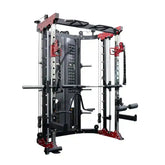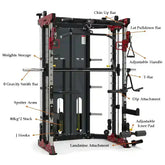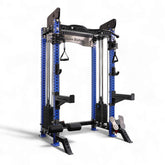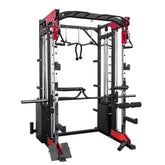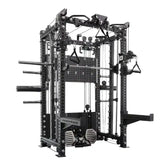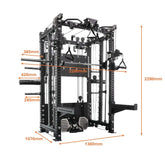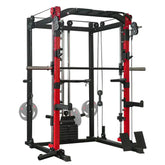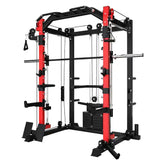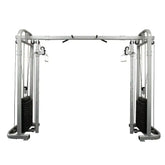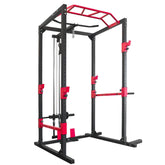Sculpt a Wide Back and Defined Arms with a Cable Machine
A cable machine helps you sculpt a wide, strong back and defined arms by delivering constant tension through every rep. Mastering the right attachments lets you train your lats, triceps, and biceps effectively for balanced upper-body strength. Pair your workouts with smart nutrition and recovery to build lean, lasting muscle.
Build a wide back and defined arms with the cable machine — master attachments, tension, and recovery for lean, lasting strength.
Why I Trust the Cable Machine for Sculpting Strength
When I was competing in bodybuilding, my training wasn’t just about lifting heavy — it was about precision and control. The goal was symmetry, balance, and that sharp definition every athlete aims for on stage.

That’s why I’ve always been a huge advocate for the cable machine. Unlike free weights, cables provide constant tension through every inch of the movement — keeping your muscles engaged even when you’re not actively contracting.
Now, as a coach training athletes and bodybuilders, I use the cable machine to help clients widen their backs, shape their arms, and enhance muscle control. It’s one of the most versatile and effective training tools for any gym — especially a home gym built for real performance.
The Muscle-Building Science Behind Cables
Cables create what I like to call “intelligent resistance.” Unlike dumbbells or barbells — which lose tension at the top or bottom of a rep — cables maintain resistance throughout the entire movement, keeping your muscles engaged from start to finish.
This consistent tension helps to:
-
Boost hypertrophy (muscle growth)
-
Enhance mind-muscle connection
-
Reduce joint strain by promoting smoother mechanics
-
Improve posture and form through controlled movement patterns
That’s why cable machines are a staple in every serious training setup — they’re the secret weapon for refinement, definition, and functional strength, not just mass.
How to Build a Wide Back with the Cable Machine
If you want that classic V-taper — wide lats, strong traps, and a defined waist — the cable machine is one of your most effective tools.
Here’s how to use it for real back development:
1. Lat Pulldown (Wide Grip)
Target: Lats and Rear Delts
-
Grip the lat pulldown bar slightly wider than shoulder-width.
-
Pull the bar down to your upper chest, keeping your back straight and shoulders relaxed.
-
Squeeze your lats at the bottom, pause, then control the release to maintain constant tension.
Coach’s Tip: Keep your chest lifted and drive your elbows toward your ribs — that’s how you fully activate your lats instead of just pulling with your arms.
2. Seated Cable Row (Close Grip)
Target: Mid-Back, Rhomboids, Traps
Sit tall with a neutral spine and grasp the close-grip handle securely.
-
Pull the handle into your lower ribs, keeping your elbows close to your body.
-
Squeeze your shoulder blades together and hold the contraction for one second.
-
Slowly extend your arms to return to the start, maintaining control throughout.
This movement develops mid-back thickness, strengthens posture, and complements wide-lat training by adding balanced density and stability to your back.
3. Straight-Arm Pulldown (Rope or Bar Attachment)
Target: Lats and Core Stability
Attach a rope or straight bar to the high pulley of your cable machine.
-
Keep your arms straight with a slight bend in the elbows.
-
Pull down in a controlled arc motion, focusing on your lats as you bring the handle to your thighs.
-
Feel the stretch at the top of each rep, and maintain tension all the way through the movement.
This isolation exercise enhances lat engagement and helps build that outer width and definition that completes a strong, athletic back.
How to Sculpt Defined Arms Using Cable Attachments
Once your back is pumped, it’s time to carve out those arms. Cables help you work the biceps and triceps through a controlled range of motion, ideal for hypertrophy and definition.
1. Cable Rope Hammer Curl
Target: Biceps and Brachialis
-
Stand upright and grasp the rope attachment with a neutral grip (palms facing each other).
-
Curl both ends upward, keeping your elbows fixed at your sides.
-
Focus on squeezing your biceps at the top, then lower slowly to maintain constant tension.
This movement develops arm thickness and forearm strength, helping you build that strong, balanced, and athletic look.
2. Cable Overhead Rope Extension
Target: Triceps (Long Head)
Attach a rope handle to the high pulley of your cable machine.
-
Step forward slightly and lean your torso forward for stability.
-
Pull the rope forward and down, extending your arms fully while keeping your elbows close to your head.
-
Pause briefly at the bottom, then return under control to maintain constant tension.
This isolation movement enhances tricep strength and definition, helping you build balanced upper arms and a complete back-arm profile.
3. Reverse-Grip Tricep Pushdown
Target: Triceps and Forearms
Attach a straight or curved bar to the high pulley of your cable machine.
-
Grip the bar with an underhand (supinated) grip.
-
Push the bar down slowly, focusing on the lower triceps contraction.
-
Control the negative phase to increase time under tension and maximise muscle engagement.
This variation enhances tricep definition and forearm stability, helping you build complete, well-balanced arm strength.
Fueling Your Cable Workouts
To train with precision, you need energy and recovery fuel — not guesswork.
Here’s what I recommend to my athletes before and after cable-focused sessions for back and arm definition:
Pre-Workout:
Have a small, balanced meal 60–90 minutes before training.
-
Carbs for control: oats, banana, or brown rice.
-
Protein for focus: eggs, yoghurt, or a simple protein shake.
Post-Workout:
After your last set, refuel with a lean protein and fast-digesting carb combo to restore glycogen and support muscle recovery.
-
Examples: grilled chicken with sweet potato, or a shake blended with fruit.
Coach’s Insight: Cables deliver constant tension — make sure your nutrition provides constant recovery. Stay hydrated and consistently feed the muscles you just trained for maximum strength and definition.
Combining Cables with Other Equipment
A cable machine can absolutely stand on its own — but it becomes even more powerful when paired with other key tools from your home gym setup:

-
Dumbbells: Provide free-range control and complement cable work for hypertrophy and strength balance.
-
Squat Rack: Enables compound lifts and power-focused lower-body sessions.
-
Adjustable Dumbbells: Offer easy progression and exercise variety without taking up extra space.
Together, these essentials form a complete training ecosystem — ideal for building a physique that’s strong, aesthetic, and balanced.
Final Thoughts from the Coach
The cable machine is one of the most underrated tools in muscle development. It allows you to train with precision, control, and constant tension — the three keys to real muscle definition.
If your goal is to widen your back, sculpt your arms, and build lasting strength, this machine delivers results you can both feel and see.
Remember — lean muscle comes from consistent effort in training, balance in nutrition, and recovery that matches your intensity. Start checking your equipment or contact us now.
Frequently Asked Questions
Can I build a full physique using only a cable machine?
Yes. A cable machine provides constant tension, which is ideal for hypertrophy and balanced strength development. Combine compound pulls (like rows and pulldowns) with isolation work for well-rounded results.
What’s the best rep range for muscle definition?
Aim for 10–15 reps per set with a controlled tempo. Focus on the squeeze and maintain tension throughout the full range of motion to maximise muscle engagement and definition.
How often should I train back and arms?
Train these muscle groups 2–3 times per week, allowing at least 48 hours of rest between sessions to ensure recovery and growth.
Is the cable machine good for beginners?
Absolutely. A cable machine provides a guided, stable range of motion, making it great for beginners learning technique and muscle activation before progressing to heavier free weights.

